Lexus IS220d 2012 Owner's Manual
Manufacturer: LEXUS, Model Year: 2012, Model line: IS220d, Model: Lexus IS220d 2012Pages: 609, PDF Size: 14.63 MB
Page 261 of 609
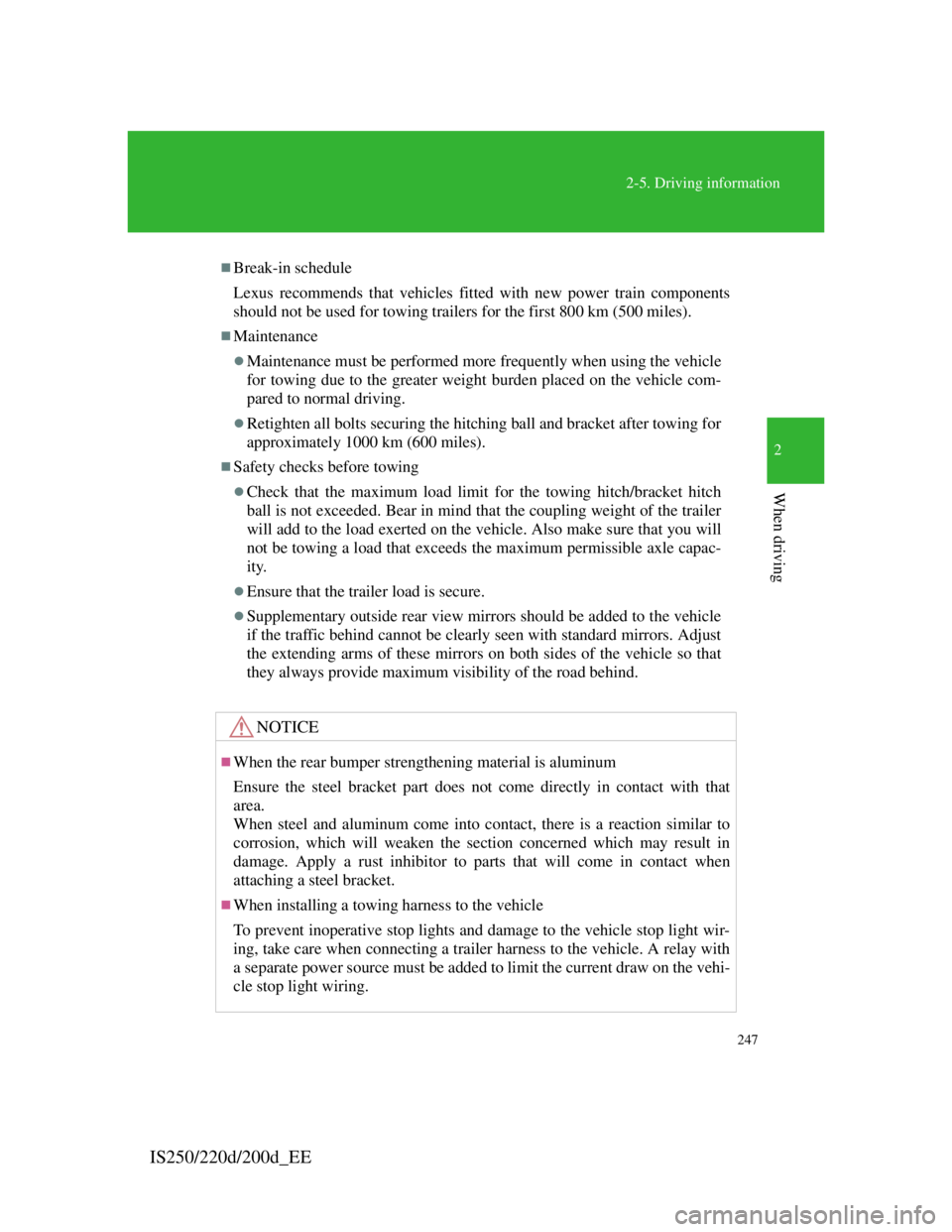
247
2-5. Driving information
2
When driving
IS250/220d/200d_EE
Break-in schedule
Lexus recommends that vehicles fitted with new power train components
should not be used for towing trailers for the first 800 km (500 miles).
Maintenance
Maintenance must be performed more frequently when using the vehicle
for towing due to the greater weight burden placed on the vehicle com-
pared to normal driving.
Retighten all bolts securing the hitching ball and bracket after towing for
approximately 1000 km (600 miles).
Safety checks before towing
Check that the maximum load limit for the towing hitch/bracket hitch
ball is not exceeded. Bear in mind that the coupling weight of the trailer
will add to the load exerted on the vehicle. Also make sure that you will
not be towing a load that exceeds the maximum permissible axle capac-
ity.
Ensure that the trailer load is secure.
Supplementary outside rear view mirrors should be added to the vehicle
if the traffic behind cannot be clearly seen with standard mirrors. Adjust
the extending arms of these mirrors on both sides of the vehicle so that
they always provide maximum visibility of the road behind.
NOTICE
When the rear bumper strengthening material is aluminum
Ensure the steel bracket part does not come directly in contact with that
area.
When steel and aluminum come into contact, there is a reaction similar to
corrosion, which will weaken the section concerned which may result in
damage. Apply a rust inhibitor to parts that will come in contact when
attaching a steel bracket.
When installing a towing harness to the vehicle
To prevent inoperative stop lights and damage to the vehicle stop light wir-
ing, take care when connecting a trailer harness to the vehicle. A relay with
a separate power source must be added to limit the current draw on the vehi-
cle stop light wiring.
Page 262 of 609

248
2-5. Driving information
IS250/220d/200d_EE
Guidance
Your vehicle will handle differently when towing a trailer. In order
to avoid accident, death or serious injury, keep the following in
mind when towing:
Checking connections between trailer and lights
Stop the vehicle and check the operation of the connection
between the trailer and lights after driving for a brief period as
well as before setting off.
Practicing driving with a coupled trailer
Get the feel for turning, stopping and reversing with the trailer
coupled by practicing in an area with no or light traffic.
When reversing with a coupled trailer, hold the section of the
steering wheel nearest to you and rotate clockwise to turn the
trailer left or counterclockwise to turn right. Always rotate
gradually to prevent steering error. Have someone guide you
when reversing to lessen the risk of accident.
Increasing vehicle-to-vehicle distance
At a speed of 10 km/h (6 mph), the distance to the vehicle run-
ning ahead of you should be equivalent to or greater than the
combined length of your vehicle and trailer. Avoid sudden brak-
ing that may cause skidding. Otherwise, the vehicle may spin
out of control. This is especially true when driving on wet or
slippery road surfaces.
Sudden acceleration/steering input/cornering
Executing sharp turns when towing may result in the trailer col-
liding with your vehicle. Decelerate well in advance when
approaching turns and take them slowly and carefully to avoid
sudden braking.
Page 263 of 609

249
2-5. Driving information
2
When driving
IS250/220d/200d_EEImportant points regarding turning
The wheels of the trailer will travel closer to the inside of the
curve than the wheels of the vehicle. To make allowance for this,
take the turns wider than you would normally.
Important points regarding stability
Vehicle movement resulting from uneven road surfaces and
strong crosswinds will affect handling. The vehicle may also be
rocked by passing buses or large trucks. Frequently check
behind when moving alongside such vehicles. As soon as such
vehicle movement occurs, immediately start to decelerate
smoothly by slowly applying the brakes. Always steer the vehi-
cle straight ahead while braking.
Passing other vehicles
Consider the total combined length of your vehicle and trailer
and ensure that the vehicle-to-vehicle distance is sufficient
before executing lane changes.
Transmission information
Refrain from driving in 6 (manual transmission) or 4 range in S
mode (automatic transmission) to maintain the effectiveness of
the engine brake and the charge performance of electrical com-
ponents.
If the engine overheats...
Towing a loaded trailer up a long steep incline in temperatures
exceeding 30C (85F) may result in the engine overheating. If
the engine coolant temperature gauge indicates that the engine is
overheating, turn the air conditioning off immediately, leave the
road and stop the vehicle in a safe place. (P. 525)
When parking the vehicle
Always place wheel chocks under the wheels of both the vehicle
and trailer. Firmly set the parking brake and shift the shift lever
to P for automatic transmissions, and 1 or R for manual trans-
missions.
Page 264 of 609
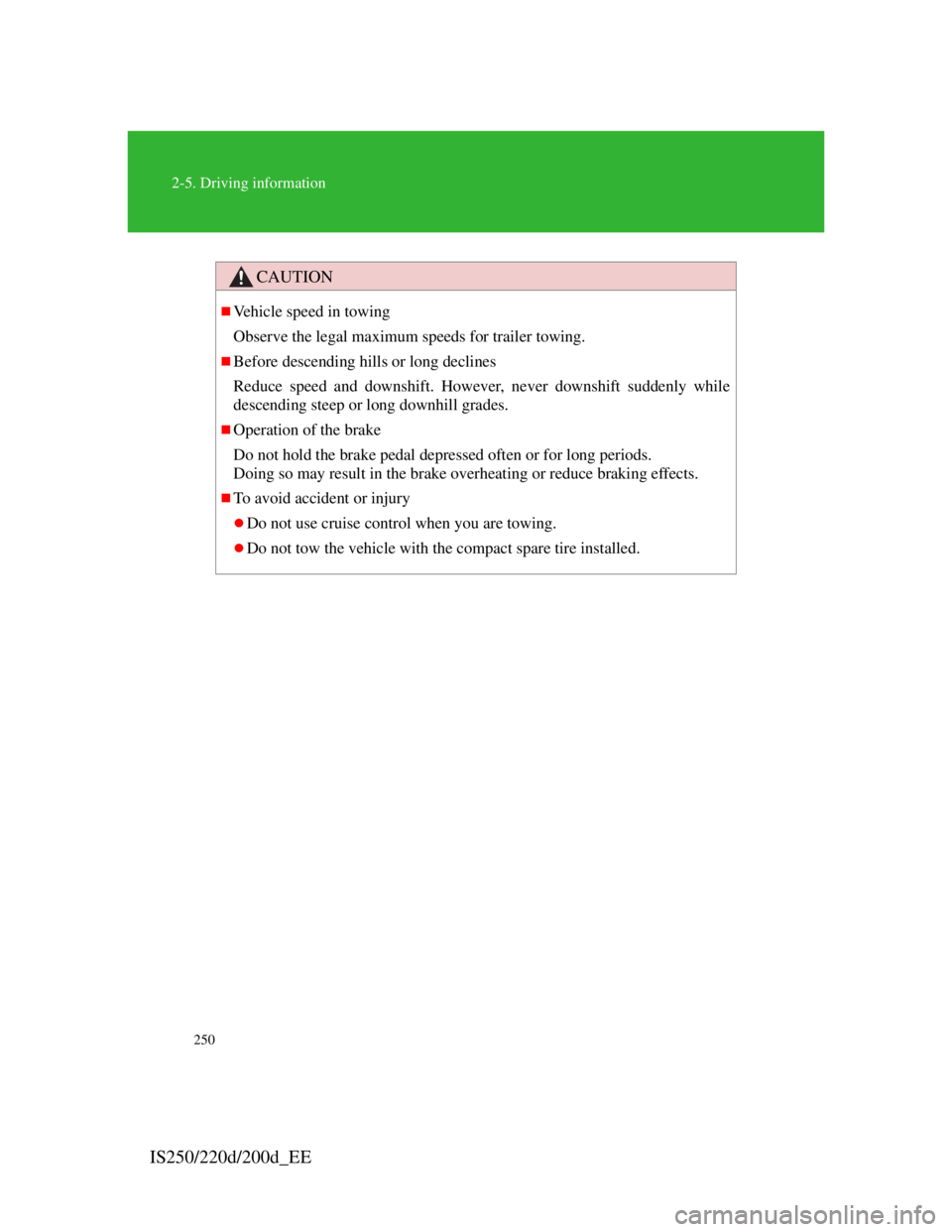
250
2-5. Driving information
IS250/220d/200d_EE
CAUTION
Vehicle speed in towing
Observe the legal maximum speeds for trailer towing.
Before descending hills or long declines
Reduce speed and downshift. However, never downshift suddenly while
descending steep or long downhill grades.
Operation of the brake
Do not hold the brake pedal depressed often or for long periods.
Doing so may result in the brake overheating or reduce braking effects.
To avoid accident or injury
Do not use cruise control when you are towing.
Do not tow the vehicle with the compact spare tire installed.
Page 265 of 609

251
2-5. Driving information
2
When driving
IS250/220d/200d_EE
Page 266 of 609
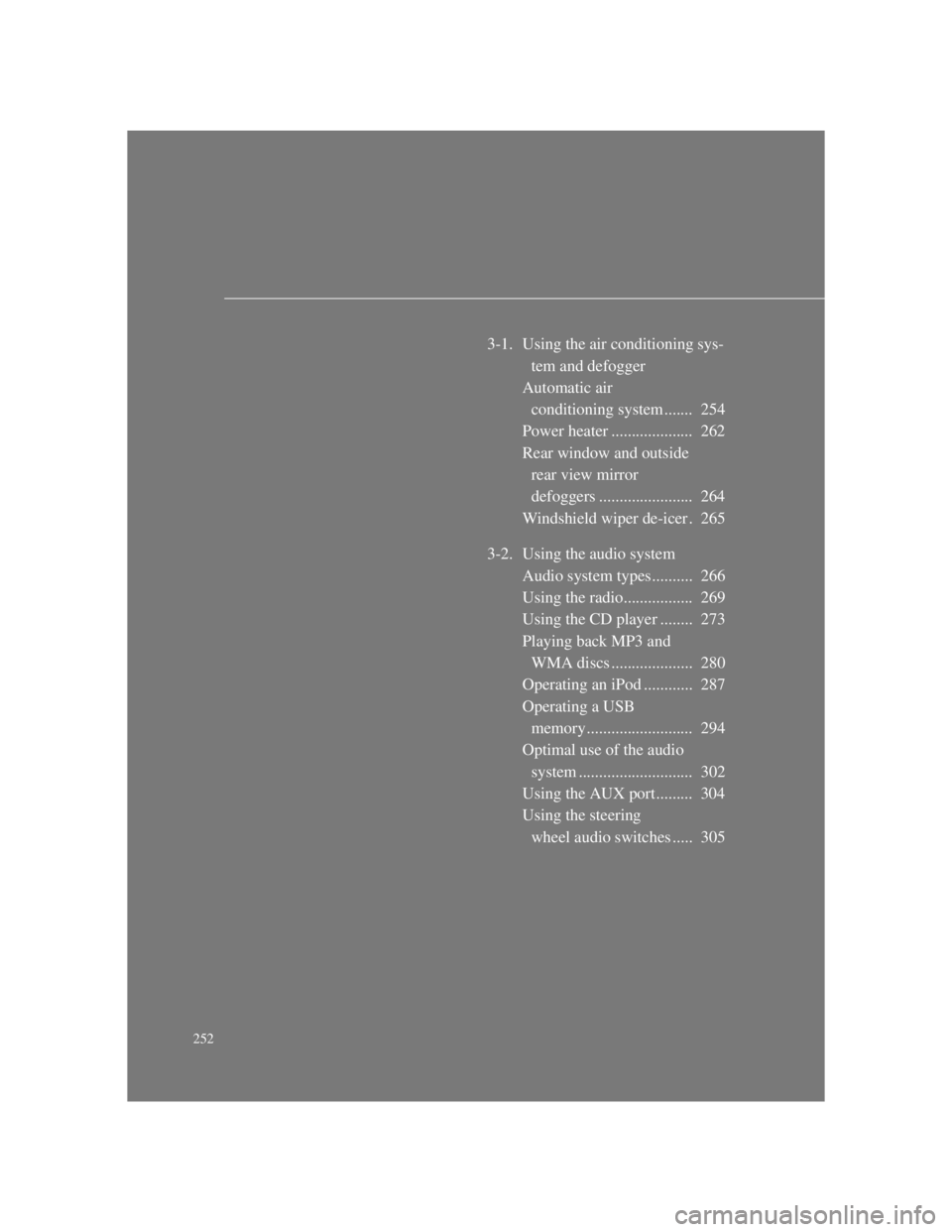
252
3-1. Using the air conditioning sys-
tem and defogger
Automatic air
conditioning system ....... 254
Power heater .................... 262
Rear window and outside
rear view mirror
defoggers ....................... 264
Windshield wiper de-icer . 265
3-2. Using the audio system
Audio system types.......... 266
Using the radio................. 269
Using the CD player ........ 273
Playing back MP3 and
WMA discs .................... 280
Operating an iPod ............ 287
Operating a USB
memory .......................... 294
Optimal use of the audio
system ............................ 302
Using the AUX port......... 304
Using the steering
wheel audio switches ..... 305
Page 267 of 609
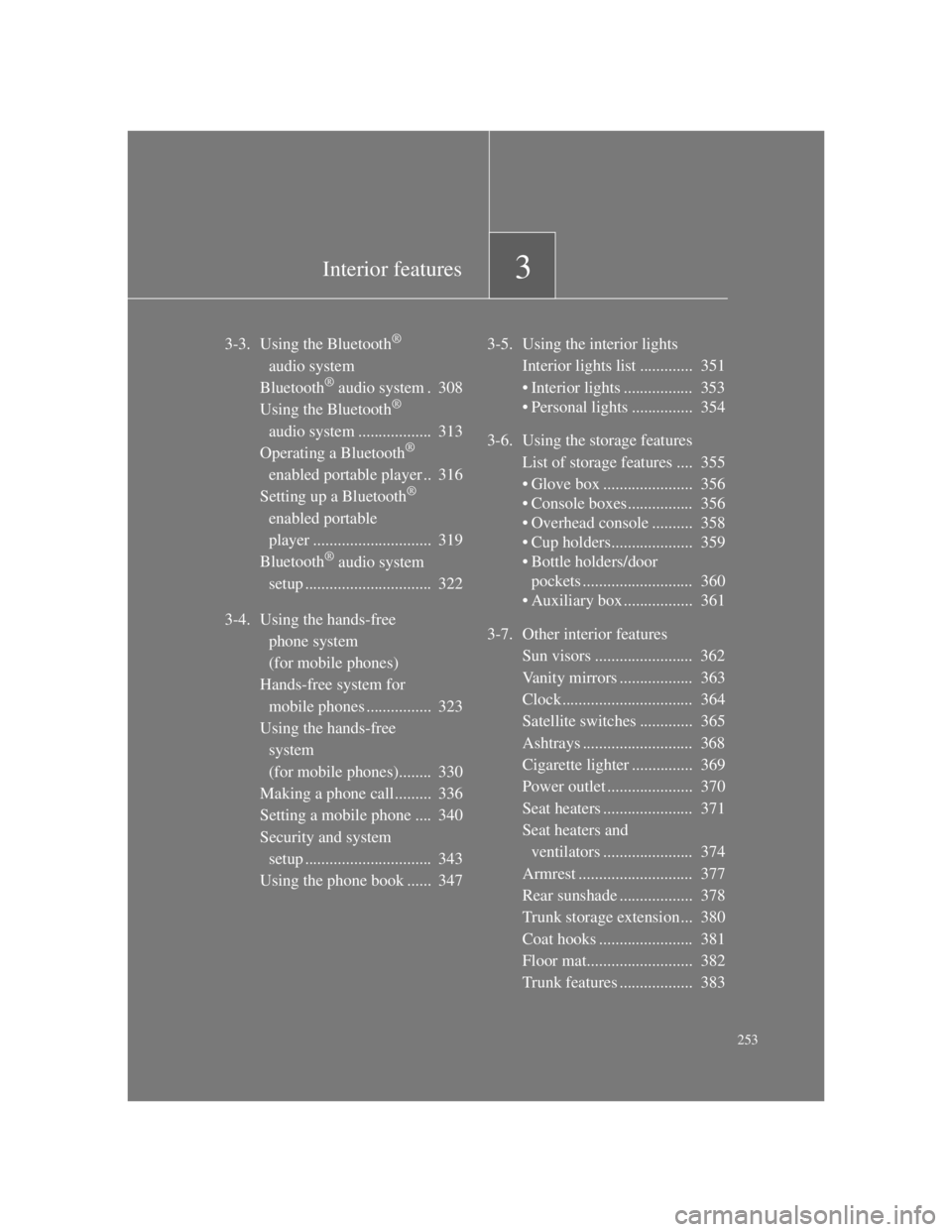
3Interior features
253
3-3. Using the Bluetooth®
audio system
Bluetooth
® audio system . 308
Using the Bluetooth®
audio system .................. 313
Operating a Bluetooth
®
enabled portable player .. 316
Setting up a Bluetooth
®
enabled portable
player ............................. 319
Bluetooth
® audio system
setup ............................... 322
3-4. Using the hands-free
phone system
(for mobile phones)
Hands-free system for
mobile phones ................ 323
Using the hands-free
system
(for mobile phones)........ 330
Making a phone call ......... 336
Setting a mobile phone .... 340
Security and system
setup ............................... 343
Using the phone book ...... 3473-5. Using the interior lights
Interior lights list ............. 351
• Interior lights ................. 353
• Personal lights ............... 354
3-6. Using the storage features
List of storage features .... 355
• Glove box ...................... 356
• Console boxes................ 356
• Overhead console .......... 358
• Cup holders.................... 359
• Bottle holders/door
pockets ........................... 360
• Auxiliary box ................. 361
3-7. Other interior features
Sun visors ........................ 362
Vanity mirrors .................. 363
Clock................................ 364
Satellite switches ............. 365
Ashtrays ........................... 368
Cigarette lighter ............... 369
Power outlet ..................... 370
Seat heaters ...................... 371
Seat heaters and
ventilators ...................... 374
Armrest ............................ 377
Rear sunshade .................. 378
Trunk storage extension... 380
Coat hooks ....................... 381
Floor mat.......................... 382
Trunk features .................. 383
Page 268 of 609
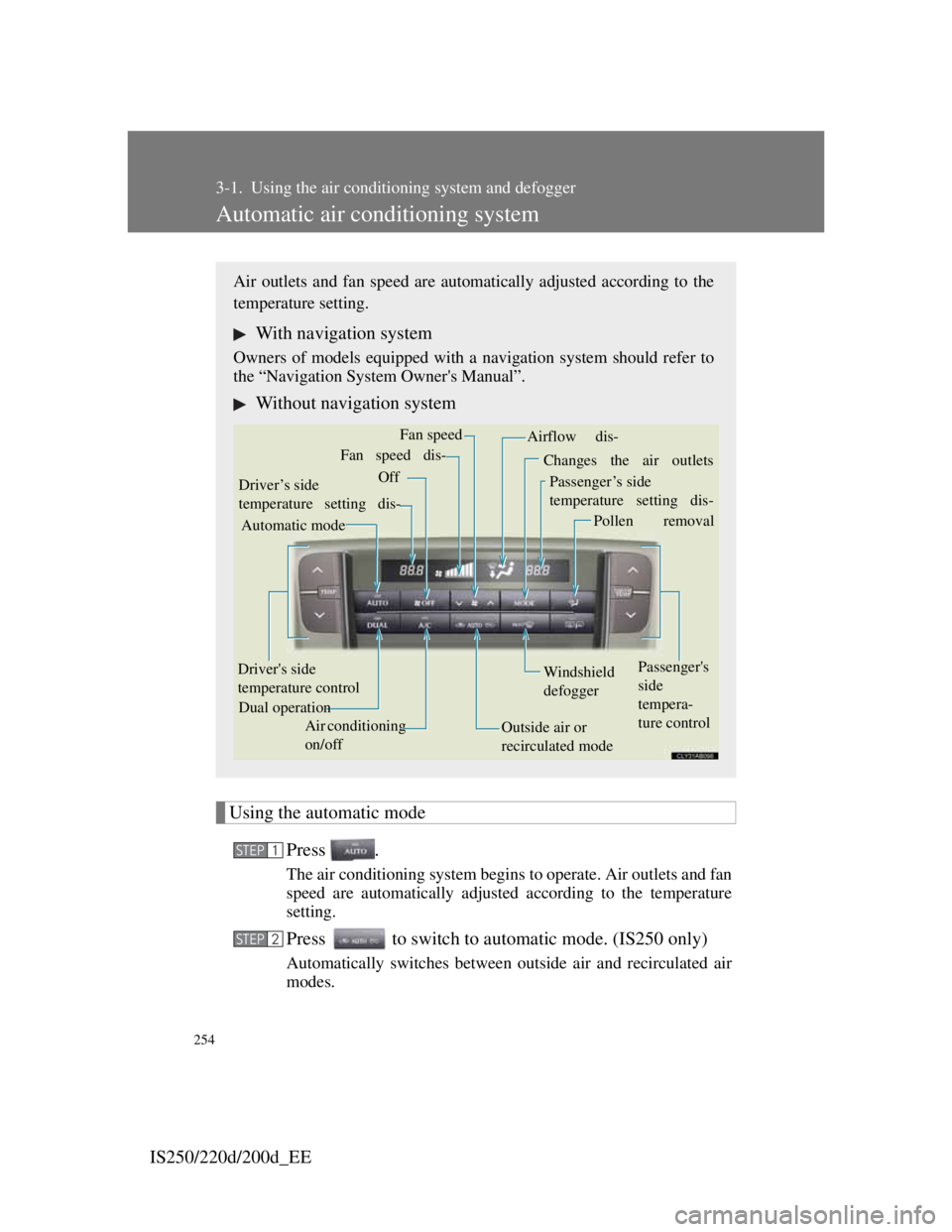
254
IS250/220d/200d_EE
3-1. Using the air conditioning system and defogger
Automatic air conditioning system
Using the automatic mode
Press .
The air conditioning system begins to operate. Air outlets and fan
speed are automatically adjusted according to the temperature
setting.
Press to switch to automatic mode. (IS250 only)
Automatically switches between outside air and recirculated air
modes.
Air outlets and fan speed are automatically adjusted according to the
temperature setting.
With navigation system
Owners of models equipped with a navigation system should refer to
the “Navigation System Owner's Manual”.
Without navigation system
Automatic mode Driver’s side
temperature setting dis-Changes the air outlets
OffFan speed
Airflow dis-
Fan speed dis-
Passenger’s side
temperature setting dis-
Pollen removal
Driver's side
temperature control
Air conditioning
on/offOutside air or
recirculated modeWindshield
defoggerPassenger's
side
tempera-
ture control Dual operation
STEP1
STEP2
Page 269 of 609
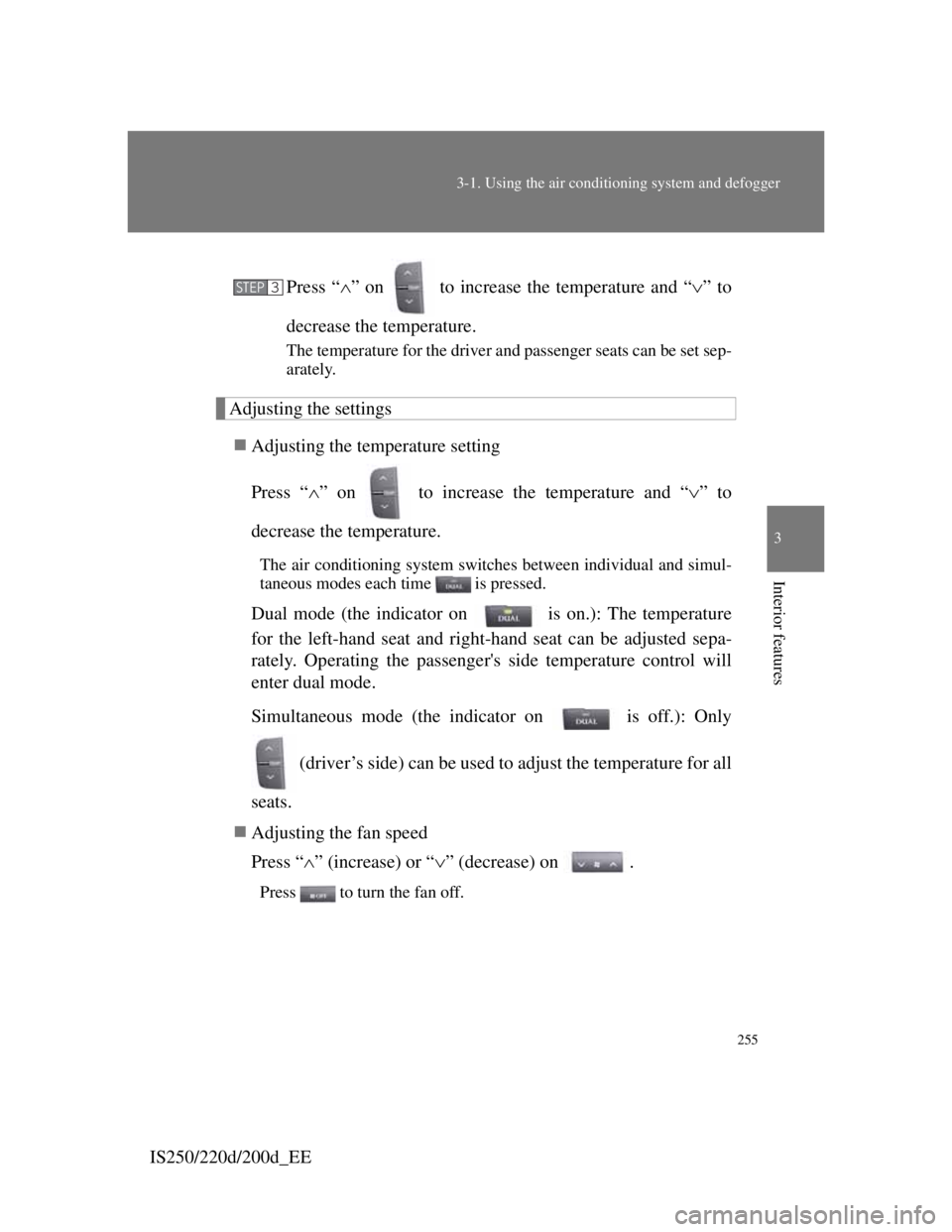
255
3-1. Using the air conditioning system and defogger
3
Interior features
IS250/220d/200d_EEPress “” on to increase the temperature and “” to
decrease the temperature.
The temperature for the driver and passenger seats can be set sep-
arately.
Adjusting the settings
Adjusting the temperature setting
Press “” on to increase the temperature and “” to
decrease the temperature.
The air conditioning system switches between individual and simul-
taneous modes each time is pressed.
Dual mode (the indicator on is on.): The temperature
for the left-hand seat and right-hand seat can be adjusted sepa-
rately. Operating the passenger's side temperature control will
enter dual mode.
Simultaneous mode (the indicator on is off.): Only
(driver’s side) can be used to adjust the temperature for all
seats.
Adjusting the fan speed
Press “” (increase) or “” (decrease) on .
Press to turn the fan off.
STEP3
Page 270 of 609

256
3-1. Using the air conditioning system and defogger
IS250/220d/200d_EEChanging the air outlets
Press .
The air outlets switch each time is pressed. The air flow
shown on the display indicates the following.
Upper body
Upper body and feet
Feet